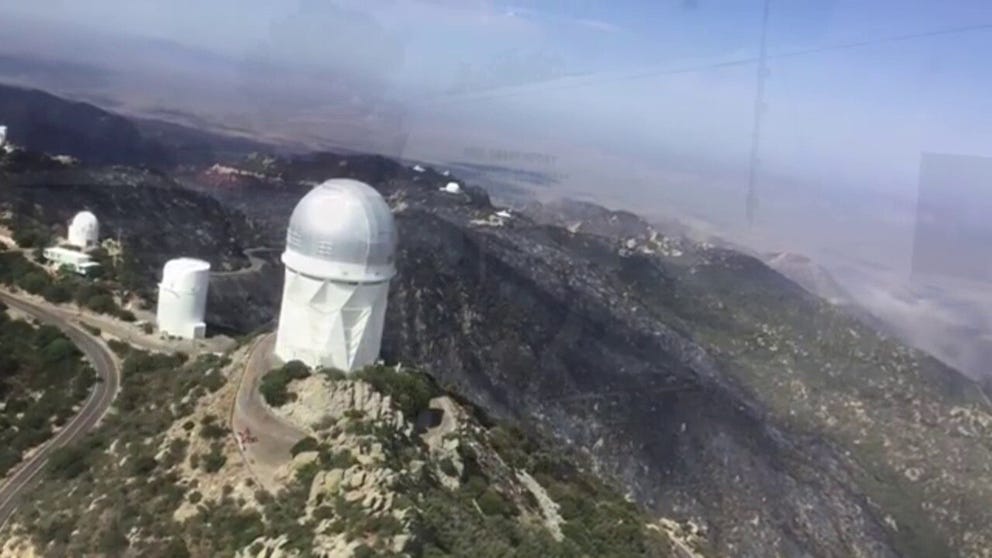Arizona observatory 'not out of danger' yet after wildfires destroy nearby buildings
Four buildings at Kitt Peak National Observatory have been destroyed by the Contreras Fire
An ongoing firefight in Arizona has so far protected a 60-year-old observatory. Still, as the Contreras Fire rages on, fueled by high temperatures and dry conditions, the astronomy facility is not out of the woods yet.
The Kitt Peak National Observatory, about an hour from Tucson, is a National Science Foundation facility that has operated since 1964. The facility is part of NSF's National Optical-Infrared Astronomy Research Laboratory, utilized by astronomers worldwide for astrophysics research.
HOW TO WATCH FOX WEATHER ON TV
On June 11, the Contreras Fire started in the Baboquivari Mountains, 8 miles south of the Kitt Peak National Observatory, about 20 miles east of Sells, Arizona, on the Tohono O'odham Indian Reservation. Fire officials said the blaze was started by lightning.
As the fire neared the observatory June 16, fire crews cleared brush from around the domes, critical infrastructure and propane tanks. The fire crested June 17 on the southwest Kitt Peak ridge, where three observatory telescopes and an array dish are located.
HOW WILDFIRE BURN SCARS COULD HAVE LASTING IMPACTS
According to Bureau of Land Management officials in Arizona, the fire jumped Kitt Peak Road and headed up the slope, making the difficult terrain challenging for fire crews.
Kitt Peak Observatory still standing after wildfire close call
Video from the Arizona Bureau of Land Management shows the telescopes and science buildings are still standing at the Kitt Peak National Observatory amid an ongoing wildfire.
Officials shared an aerial video of the fire and the first Kitt Peak National Observatory survey after the smoke cleared.
Kitt Peak Associated Director Michelle Edwards and Safety Manager Joe Davis could view the buildings from a distance and reported all science structures were still standing. However, four non-science buildings, including dormitories and support buildings, were lost, according to the NSF's NOIRLab.
SHEEP FIRE? PIPELINE FIRE? HERE IS HOW WILDFIRES GET THEIR NAMES
The fire continues to be active around the Kitt Peak National Observatory as of Monday night. At 20,360 acres, the blaze is now 40% contained, according to the fire management team.
"While we are not out of danger, the situation is improving," the NSF NOIRLab said in an update.

The Tucson, Arizona forecast for this week includes triple-digit temperatures and some storms.
(FOX Weather)
As of Monday, all the telescope domes were still standing. Firefights are ongoing near the McMath-Pierce Solar Telescope and the Window on the Universe Center.
"It has not been possible to visit the observatory with a damage assessment team yet to evaluate the state of the telescopes," NSF's NOIRLab wrote. "The entire observatory is still considered too dangerous and is open only to the firefighting teams."
According to the Eastern Area Incident Management Team, fire activity has increased over the weekend due to decreased cloud cover, hot temperatures and lower relative humidity.
NEW SUMMER FORECAST DAMPENS HOPES FOR DROUGHT RELIEF IN WEST
Wildfire season in the west has been unrelenting this year. According to the U.S. Drought Monitor, most of Arizona is in severe drought, with areas near state lines in exceptional drought.
The Southwest monsoon season officially started June 15 and could bring much-needed rain to drought-stricken areas but will also bring the threat of flash flooding.
This week, Tucson temperatures will continue in the triple-digits with possible thunderstorms later in the week.

Active wildfires as of Monday, June 20, 2022.
(FOX Weather)
CLICK HERE TO GET THE FOX WEATHER UPDATE PODCAST
Be sure to download the FOX Weather app to track any storms in your area and receive potentially life-saving weather alerts issued by the National Weather Service. The free FOX Weather livestream is also available 24/7 on the website and app and on your favorite streaming platform. The FOX Weather Update podcast also provides weather information for the entire country.





